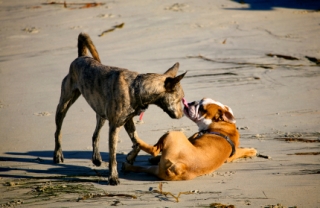Dominance Dilemma

Konnichiwa, dog aficionados. I am sitting here in a hotel room in warm and sunny downtown Tokyo contemplating some talks I am due to give between now and June 1st. The first is on canine aggression and when it comes to owner-directed aggression, the type of aggression formerly known as dominance aggression, I often find myself somewhat stuck for words. A recent article by Sophia Yin in the Huffington Post explains current thinking on the matter and gives some pointers (not German short-haired ones though). The gist of the article is correct, that physical punishment in dog training is passé and, whatever TV made lead you to believe, is counterproductive.
I agree with most of what Sophia says and agree wholeheartedly with the anti-violent approach but cannot for the life of me come to grips with the idea that dominance no longer exists in the canine psyche. After all, that’s how cohesion is maintained in a group setting (I daren’t say “pack” because that is no longer fashionable parlance). A formal hierarchy obviates the need for constant squabbles.
What most people seem to be missing in these discussions is that dominance and aggression are not synonymous. In fact, they often move in opposite directions. True alphas, of the canine or human kind, are rarely aggressive. So that begs the question “why would a dog in a domestic setting be aggressive to his owners?” Is it because he is alpha? Not likely. Is it because he is fearful of his owners? No way. It seems to occur when – okay, the pack – is unstable. In that case, there is lack of understanding between the various elements of the group, unclear communication, no set rules, and so on. In this situation, a canine “wanna-be” may try it on, when the mood takes him, in an attempt to have things go his way.
This type of aggression, called “instrumental” aggression in one classification, occurs in reasonably well defined circumstances, involving resource guarding, invasion of personal space, and general willfulness. Affected dogs may be totally unperturbed by strangers and enjoy their owners’ company. They are often described as the most wonderful dogs, ones who seek their owners’ petting and attention, except for 2 percent of time when they “grow horns” and adopt their Mr.Hyde mode. Between times they do not appear to be overly anxious or fearful though they may have some foibles. Aggression, in the form of growls, lip lifts, snarls, snaps, and bites, is brief and to the point. It is only intended to send a message – though the message can sometimes be overly severe.
If this condition was purely driven by fear and anxiety, as opposed to a mix-up over who’s who in the household, why would it be more common in males? Why would it be reduced by castration? Why would affected dogs sometimes engage in humping? Why would affected dogs show confident territoriality and pick occasional fights with other willful dogs? Why would bites be directed more toward children and easy going adults? Why would bites be directed toward hands and faces (muzzles) than the rear attack sites (“cheap shots”) of fearful dogs? Why would the likelihood of aggression increase in the evening hours and when the dog is tired?
I think there are two components operating in most cases of owner-directed aggression. One is willfulness (“dominance”) and the other is uncertainty over the owners' actions (and general role in the household). No dominance means no aggression. No uncertainty (over the owners’ role) also eliminates aggression. One thing’s for sure, avoiding unnecessary encounters (“conflicts”) and having the dog understand who controls all valued assets – what I call a Leadership Program – resolves most of the issues in 90 percent of dogs in a period of two months. A rose like this by any other name by any other name should smell this sweet. Okay, now that’s out of my system I will head on out to the first talk and just hope my ideas translate well.
Editor's Note: If you'd like to hear more from Dr. Dodman but can't get to Japan, he'll be speaking in the U.S. in June with Dr. Ian Dunbar and again in November in Boston.




